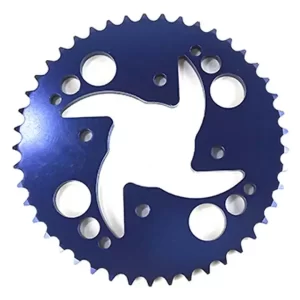Custom Chains And Sprockets For Motorcycles
MPM has a decade-long track record of delivering OEM and ODM services for customs the best motorcycle chain and sprocket kits. Our custom motorcycle parts have gained a strong global presence.
As a motorcycle manufacturer, brand owner, or motorcycle parts wholesaler, you can partner with MPM to manufacture your brand’s chain and sprocket products according to your specifications. Additionally, if you need chains and sprockets with specific specifications or custom designs, MPM is fully equipped to produce them based on your unique requirements.
MPM is committed to collaborating with customers to provide tailored solutions that meet their individual needs.
Custom Motorcycle Chains & Sprockets
-

Custom Best Steel Ladle Aluminum Motorcycle Rear Sprockets for KTM Duke690
-

Custom Motorcycle Billet Aluminum Rear Sprockets for KTM Duke200
-

Motorcycle kmx 125 rear sprocket for Kawasaki KMX125 KMX200
-

Custom aluminum motorcycle rear sprocket for Suzuki 150 Gixxer
-

Custom aluminum motorcycle rear sprocket for AKT TTX 180
-

Custom aluminum motorcycle rear sprocket for Kawasaki Ninja 250 300
-

Custom aluminum motorcycle rear sprocket for TVS Apache 200
-

Custom aluminum motorcycle rear sprocket for AKT CR5 180
FAQ about chain and sprocket kits for motorcycle
The lifespan of a motorcycle chain and sprocket can vary depending on several factors, including the quality of the components, maintenance practices, riding conditions, and the type of motorcycle. Here are some general guidelines for the lifespan of motorcycle chains and sprockets:
1. Quality of Components: High-quality chains and sprockets made from durable materials such as hardened steel or alloy can have a longer lifespan compared to lower-quality components.
2. Maintenance: Regular maintenance, including cleaning, lubrication, and proper tensioning of the chain, can significantly extend the lifespan of the chain and sprocket. Neglecting maintenance can lead to premature wear and reduce their lifespan.
3. Riding Conditions: Riding in harsh conditions such as off-road, wet or muddy environments, or extreme temperatures can accelerate wear on the chain and sprocket, reducing their lifespan.
4. Type of Motorcycle: The type of motorcycle and its engine power can also impact the lifespan of the chain and sprocket. Higher-powered motorcycles may put more stress on the chain and sprocket, leading to faster wear.
As a general rule of thumb, a well-maintained motorcycle chain and sprocket can typically last anywhere from 20,000 to 30,000 kilometers. However, it’s important to regularly inspect and maintain the chain and sprocket and replace them if signs of wear or damage are present. Regular maintenance and timely replacement can help ensure safe and efficient operation of the motorcycle.
Matching a sprocket to a chain involves ensuring that the pitch and the number of teeth on the sprocket are compatible with the pitch and size of the chain. Here’s how you can match a sprocket to a chain:
1. Determine the Chain Size: The first step is to identify the size and type of the chain you are using on your motorcycle. This includes the pitch (the distance between the rollers) and the width of the chain.
2. Select the Sprocket Pitch: Once you know the pitch of the chain, you can select a sprocket with a matching pitch. It’s crucial to ensure that the pitch of the sprocket matches the pitch of the chain. Common chain pitches for motorcycles include 520, 525, and 530.
3. Consider the Number of Teeth: The number of teeth on the sprocket will affect the gear ratio and the performance of the motorcycle. You can choose a sprocket with a different number of teeth to achieve specific performance characteristics, such as acceleration or top speed. However, it’s essential to ensure that the sprocket is compatible with the chain in terms of pitch and width.
4. Check for Compatibility: Once you have selected a sprocket that matches the pitch and width of the chain, verify that the sprocket is compatible with your motorcycle’s make and model. Different motorcycles may have specific sprocket requirements based on the overall gear ratio and performance characteristics.
By following these steps and ensuring that the pitch, width, and number of teeth on the sprocket are compatible with the chain, you can effectively match a sprocket to a chain for optimal performance and durability.
It’s generally recommended to lubricate your motorcycle chain every 300-600 miles (500-1000 kilometers) or more frequently if you ride in wet or dusty conditions. However, the specific lubrication interval may vary based on factors such as the type of riding, environmental conditions, and the type of lubricant used.
Here are some guidelines for lubricating your motorcycle chain:
1. Regular Inspection: Check the condition of your chain regularly. Look for signs of dryness, rust, or excessive dirt buildup. If the chain appears dry or dirty, it’s time for lubrication.
2. Clean Before Lubricating: Before applying new lubricant, it’s important to clean the chain to remove dirt and old lubricant. You can use a dedicated chain cleaner or a mild solvent and a brush to clean the chain.
3. Apply Lubricant: Use a high-quality motorcycle chain lubricant and apply it evenly along the entire length of the chain while rotating the rear wheel. Avoid over-lubricating, as excess lubricant can attract dirt and debris.
4. Allow Time to Penetrate: After applying the lubricant, allow it some time to penetrate the rollers and pins of the chain. This will help ensure effective lubrication.
5. Wipe Excess: After the lubricant has had time to penetrate, use a clean cloth to wipe off any excess lubricant from the chain. This helps prevent dirt buildup and keeps the chain clean.
By following these guidelines and adjusting the lubrication frequency based on your specific riding conditions, you can help maintain the performance and longevity of your motorcycle chain.










